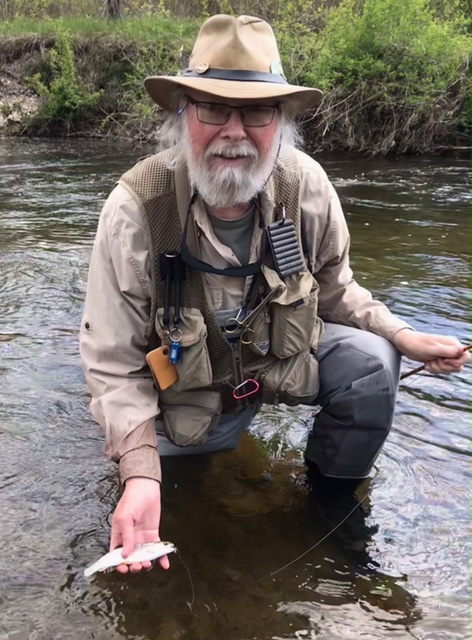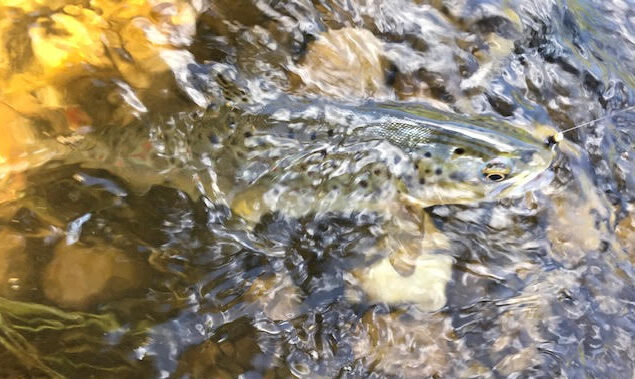For most of my seventy years I never gave much thought to the greening month of May. Even acknowledging that it arrived on the heels of the austerity of March and the promise of April, it was not until I started fly fishing that May acquired meaning and significance for me.
Although trout season opens on the fourth Saturday of April, things really don’t get hopping until the first or second week of May when warming temperatures, increasing daylight and declining river flows trigger bug hatches. High fast water, which can be dangerous to wade for old-timers like me, and chucking streamers, woolly buggers and such questionable synthetic thingamajigs as San Juan worms and Mop flies are not my idea of a good time.
It was the first day of May–May(fly) Day, celebrated by the ancient Celts as Beltane in recognition of both the apex of spring and the coming of summer, and associated with fertility. My angling buddy Dan Kennaley and I hit Whitman’s Creek, a rite of renewal and regeneration we have enacted regularly over the past few seasons.
In real life I have shunned long courtships. Viewing the midway from atop the Ferris wheel has bestowed abundant thrills before the inevitable descent and accompanying heartbreak. Likewise, I usually fall in love with rivers at first blush, with the exception of Whiteman’s. For many years I was unimpressed with her charms, failing to see her for what she is: a beauty.

For a small river, Whitman’s abounds in trout including rainbow and steelhead, the latter of which spawn in the river, surprisingly large resident brown trout and the occasional brook trout. It also has smallmouth bass. It flows into the Lower Grand River between Paris and Brantford through the 266-acre Apps Mill Nature Centre.
Dan is fond of the ‘creek’ because it evokes pleasant memories of growing up in Brantford and in the nearby countryside, where he first learned to fish.
I was more conflicted towards the tributary before affection finally won me over. It is where I joined Dan and Jeff Thomason on my first outing as a fly angler. That single fact is enough to make the ‘creek’ special. However, it is also where I suffered my first fly fishing indignity–the first of many. The humiliation involved filling my waders and vest with cold water, causing me to dry off by stripping down to my birthday suit so the smirking sun could dry off my clothes and gear.
Things went better on this Saturday, despite cool temperatures and strong winds that conspired to bring rain showers which, as it turned out, never materialized. Dan and I together could have counted on the fingers of our hands the few light raindrops that fell.
Dan added some birds to his seasonal list, while I took delight in a couple of spotted sandpipers, birds I had not seen for many years, in addition to a pileated woodpecker (quite rare) and red-tailed hawk, a pair of Eastern kingbirds and multiple blue jays, black-capped chickadees, red-winged blackbirds and grackles.
I know grackles get a bad rap because of their gluttony and aggressiveness. To my way of thinking, grackles are no more rapacious or aggressive than fish. Similarly, to my eye, the males’ iridescent emerald-blue head, dark bronzy body and purple-tinged wings make them striking specimens.
I recall grackles being favourite birds of one of my childhood friends, Norm Harris. We used to spend a lot of time exploring nature along the flood plain of the south branch of the Thames River—known appropriately if viewed aerially, as Deshkan Ziibi [Antler River] in the Ojibwe language spoken by the Anishnaabe people—in our hometown of London, Ontario. Like my dad, Norm’s father was a firefighter and for many years Norm worked with my younger brother, Steve. As a youngster a couple of years older than me, Norm trapped muskrats and other fur-bearing animals within city limits, which I savoured as a constant source of amazement.
Dan and I both enjoyed a pleasant and fulfilling day. He caught fourteen rainbows over seven hours of angling and birding, beginning with the lovely cinnamon Bi-visible he ties before switching to a hybrid nymph of some kind. His fish of the day was the mythic one-that-got-away.
‘Don’t know what the one really good fish (italics mine) was that I lost,’ Dan explained. ‘Could have been a brown, but might have been a steelhead. I did catch a couple of small rainbows in the same run where I lost the good one.
‘I hooked and lost it on the way downriver and, of course, I tried the spot on the way back up. Sure enough I got a hit on my nymph again and, thinking it might be the good one, I set the hook hard, only to propel a poor innocent six-incher over my head into the vegetation behind me.’
I emphasized with my angling companion. This happens to all fly anglers. Anyway sympathy is the fly line that binds all angling friendships.
I caught ten rainbows over three hours, seven of which were no larger than fingerlings with the exception of a six-incher, seven-incher and nine-incher. All caught on one of Dan’s cinnamon Bi-visibles, an impressionistic dry fly that is productive during the Hendrickson hatch, the first major hatch in southwestern Ontario.
Dan refers to his Bi-visible as brown, conceding that the tightly palmered hackle feathers and tail fibres are reddish-brown. I think my description is more poetic (laugh). I admire the fly because, in addition to being an early season trout magnet (especially on waters where trout tend to be naive), it is easy to see on the the water because of its Size 12 profile, buoyancy (it is bushy) and dashing white hackle collar. Its high visibility benefits angler and trout equally, even on rough water.
I have never been a fan of tiny flies–for me this means Size 18 which I admit is not close to tiny for proficient technical anglers–tied on wispy leaders longer than nine feet and thinner than 6X. As I have gotten older, and my eyes have aged in consort with my body, I have come to praise bigger, bushier flies, provided they work. I know there are ‘tricks’ that make small flies easier to see–small strike indicators and fluorescent ‘strike putty’ and such–but I prefer a clean line devoid of any remnants of worm-chucking (just kidding).

landed and photographed by Chris Pibus
My biggest ‘bow was rewarding for the unique circumstances in which he was caught, which I will describe momentarily. The others were gratifying for a reason that does not get the attention it deserves. In terms of fly angling glory, there is nothing more esteemed than casting upstream, targeting and catching specific rising trout. If the angler ties the dry fly, so much the better.
What is not acknowledged enough, in my opinion, is the way I caught all my trout: by reading the water, thinking like a trout, and casting to places where trout are expected to be holding. Even when the fish does not eat the fly, catching a glimpse of the approach and rejection is exciting, as is flubbing the hook set. I don’t see why this methodology is not as strong a connection between angler and fish as when an angler knows, in advance, where a fish is rising.
I know such acclaimed angling writers as Tom Rosenbauer have written comprehensively about this topic (I recommend his Orvis Guide to Reading Trout Streams and Orvis Guide to Prospecting for Trout). However, I stand by my opinion, at least in terms of the long history of dry fly angling literature.
My biggest trout was even more special. Dan and I had just mused about how we have reached the age where prospecting water includes ascertaining whether there are any natural benches suitable for sitting and resting, maybe even reflecting and contemplating (like Thoreau sitting on a pumpkin). These might include boulders, raised grassy riverbanks suitable for sitting while dangling ‘wadered’ legs in water, or sweepers and deadfall sufficient to bear an angler’s weight.
No more than ten minutes after chatting with Dan I came across a half-submerged tree trunk laying parallel and adjacent to a rushing current. I sat down, resting comfortably, and casually started what fly anglers refer to as a parachute cast downriver in the current seam caused by the trunk and a rocky ledge over which water was swirling.
By stopping my fly rod high over my head, allowing the fly to float gently onto the water, and then lowering my rod tip, the fly drifted naturally in the current a fair distance. I extended the drift by flipping out more line with the tip of my seven-and-a-half foot, three-weight bamboo rod. It didn’t bother me that the dry fly eventually sank. I simply stripped in more line and raised my rod, then lowered it and let more line drift along, allowing the sunken fly to drift subsurface even farther in the current.
After repeating this a of couple of times, the nine-incher gobbled the fly. I set the hook and brought him into my wet hand, released the barbless hook and returned him from whence he came, no worse for wear. I found the whole thing immensely gratifying, confirming that age need not be a handicap—provided nature offers a helping hand.
Unfortunately Dan had moved off, downriver, and missed my best impression of angling legerdemain. I was so pleased with our outing I was eager to introduce Whiteman’s Creek to Chris Pibus, my newest angling companion, in addition to a couple of fly fishing apprentices I have taken under my rod, Doug Kirton, to whom I coached baseball fifty-five years ago, and my eldest son, Dylan. My youngest son, Robertson joined the fun with his spinning gear equipped with a small modified (single barbless hook) Rapala. Fly angling is cloaked in the intrigue of secret places but, at my age, sharing the bounty with dear angling companions is part of the satisfaction.
The lovely day on the water got me pondering on the hour-drive home. As I contemplated what I had learned in seventy years, I began musing about what fish have taught me, a more satisfying preoccupation:
• Fish have given me the gift of surprise and joy, wonder and bliss, sometimes not without apprehension or even fear.
• Fish have grounded me in a particular place despite my living in an increasingly rootless world.
• Fish have helped me feel a strong bond to a larger community at a time when people feel increasingly alienated and isolated from nature.
• Fish have inspired wonder and awe. They have given me the keys—humility and respect—through which to open the door onto mystery.
• By allowing me to participate in their lives, if only briefly, fish have nourished, enriched and enlarged my kinship to fellow creatures with whom I share common origin in the stew of our mutual primordial beginnings.
When people ask me why I fly fish, invariably adding without my prompting that they would find it interminably boring–in short, a waste of time–and more than a little cruel, I am rendered speechless. Very occasionally words fail me.